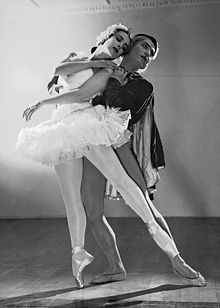Nora Kaye
| Nora Kaye | |
|---|---|
| Born | New York City, New York U.S. |
| Died |
February 28, 1987 (aged 67) Los Angeles, California U.S. |
| Occupation | ballerina |
Nora Kaye (January 17, 1920 - February 28, 1987) was an American prima-ballerina. Called the Duse of Dance after the acclaimed actress Eleonora Duse. She also worked in films as a choreographer and producer and performed on Broadway.
Personal life
Kaye was born Nora Koreff in Brooklyn, New York, the daughter of Russian Jewish immigrant parents Louise (1895-1973) and Gregory Joseph Koreff (1893-1976).[1] She later Americanized her surname to Kaye.
Career
In 1936, she joined the American Ballet, directed by George Balanchine. She later became a member of the Radio City Music Hall corps de ballet and danced in several Broadway productions, including Giselle (1941), Antony Tudor's Pillar of Fire (1946), and Two's Company (1952), a revue starring Bette Davis. She worked as an assistant on the musicals I Can Get It for You Wholesale (1962), Tovarich (1963), and On a Clear Day You Can See Forever (1965).
Kaye's marriage to Isaac Stern in November 1948 ended in divorce the following year. She married the film director, producer, choreographer and actor Herbert Ross in August 1959. The couple collaborated on several screen projects, including Goodbye, Mr. Chips (1969), The Last of Sheila (1973), Funny Lady and The Sunshine Boys (both 1975), and The Seven-Per-Cent Solution (1976). Playwright and screenwriter Arthur Laurents claimed in his autobiography Original Story By (2000) that he and Kaye had an on-again, off-again romantic relationship after he was discharged from the U.S. Army in 1946.[2]
Kaye's producing credits include The Turning Point (1977), Nijinsky (1980), Pennies from Heaven (1981) and The Secret of My Succe$s (1987).
Kaye died from cancer in Los Angeles at age 67, and is buried with her husband Herbert Ross in the Westwood Village Memorial Park Cemetery in Los Angeles. Their gravestone is inscribed "They Loved Each Other".
Kaye was childhood friends with fellow dancer Isabel Mirrow Brown, about which the film The Turning Point is based on.
References
- ↑ https://familysearch.org/pal:/MM9.1.1/VGT9-R9Y accessed 8/23/14
- ↑ Arthur Laurents, Original Story By Arthur Laurents: A Memoir of Broadway and Hollywood (Alfred A. Knopf, 2000), pp. 41–49 ISBN 978-0-375-40055-1
External links
- Nora Kaye at the Internet Movie Database
- Nora Kaye at the Internet Broadway Database
- Archival footage of Nora Kaye and Hugh Laing performing in Balanchine's The Gods Go a-Begging in 1951 at Jacob’s Pillow Dance Festival.
- Kaye's picture
- Nora Kaye (1920-1987)
- NY Times obituary, March 1, 1987
- NY Times article by Jack Anderson, January 5, 1988
|
| ||||||||||||||||||||||||||||||||||||
